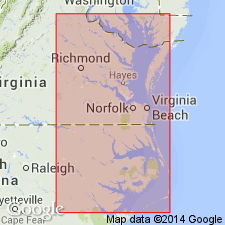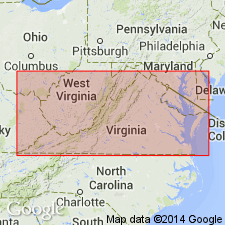
- Usage in publication:
-
- Moore House Member*
- Modifications:
-
- Named
- Dominant lithology:
-
- Limestone
- Shell hash
- AAPG geologic province:
-
- Atlantic Coast basin
Summary:
Named as member of Yorktown Formation. Named for Moore House, Colonial National Historical Park [Yorktown Battlefield Park], York Co., eastern VA. Occurs in easternmost VA (including very southernmost Delmarva Peninsula), and northeasternmost NC. Consists of orange sandy shell beds and cross-bedded shell hash; locally cemented to very indurated rock; also includes tan, clayey, highly calcareous sand containing abundant mollusks (CREPIDULA, oysters, pectens), foraminifers, and ostracodes; glauconitic and phosphatic in places. Thickness is as much as 6 m. Conformably overlies Morgarts Beach Member (new); members grade into each other in places. Report includes generalized geologic map, correlation chart, and fossil lists. Shares molluscan assemblage with Morgarts Beach and Rushmere Members (too numerous to list here). Age is late Pliocene.
Source: GNU records (USGS DDS-6; Reston GNULEX).

- Usage in publication:
-
- Moore House Member
- Modifications:
-
- Revised
- AAPG geologic province:
-
- Atlantic Coast basin
Summary:
Author states that the single Yorktown transgressive-regressive cycle model endorsed by many works, including Campbell and others (1975) and Ward and Blackwelder (1980) is now untenable. Consequently the members proposed by Ward and Blackwelder based on that model are in need of revision. The Rushmere, Morgarts Beach, and Moore House Members are not lithostratigraphic units as presently defined. Their characteristic sediment types recur frequently through the Yorktown section. They are non-coherent when examined against the Krantz (1991) oxygen isotope model. They are mappable only if restricted to their definitions at their stratotype sections. Only the Sunken Meadow is unchanged in this report. Author specifically points to the Moore House Member as being "conceptually muddled." Though described at its stratotype by Ward and Blackwelder (1980) as containing 1 m of fragmental sand and 3 m of tan, clayey, highly calcareous sand, their fig. 20 assigns the 3-m bed to the Morgarts Beach. Author concludes that the Moore House stratotype (bed f of Mansfield (1944)) most likely belongs to K-6 (Krantz, 1991) and its underlying clay bed does not belong to the Morgarts Beach Member.
Source: GNU records (USGS DDS-6; Reston GNULEX).
For more information, please contact Nancy Stamm, Geologic Names Committee Secretary.
Asterisk (*) indicates published by U.S. Geological Survey authors.
"No current usage" (†) implies that a name has been abandoned or has fallen into disuse. Former usage and, if known, replacement name given in parentheses ( ).
Slash (/) indicates name conflicts with nomenclatural guidelines (CSN, 1933; ACSN, 1961, 1970; NACSN, 1983, 2005, 2021). May be explained within brackets ([ ]).

